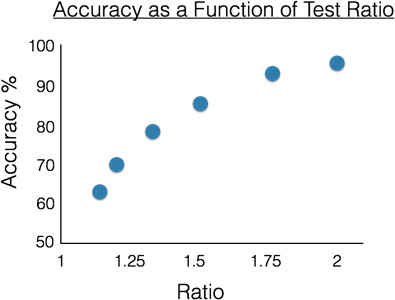Sign In
JoVE Science Education
Cognitive Psychology
A subscription to JoVE is required to view this content.
Approximate Number Sense Test
Source: Laboratory of Jonathan Flombaum—Johns Hopkins University
A common carnival game is to ask people to guess the number of jellybeans packed into a jar. The chances that anyone will get the exact number right are low. But what about the chances that someone will guess 17 or 147,000? Probably even less than the chances of guessing the correct answer; 17 and 147,000 just seem irrational. Why? After all, if the beans cannot be taken out and counted one-at-a-time, how can someone tell that an estimate is too high or too low?
It turns out that in addition to verbal counting (something clearly learned), people appear to possess hardwired mental and neural mechanisms for estimating numbers. To put it colloquially, it is what might be called an ability to guesstimate, or “ballpark.” Experimental psychologists call it the “Approximate Number Sense,” and recent research with an experimental paradigm of the same name has begun to uncover the underlying computations and neural mechanisms that support the ability to guesstimate.
This video demonstrates standard procedures for investigating nonverbal numerical estimation with the Approximate Number Sense Test.
1. Stimuli and trials
- Program the experiment in Psychopy, MATLAB, or something similar (a free version can also be downloaded for non-commercial uses at www.panamath.org).
- Design all trials in the experiment to look more or less the same.
- Divide the display in half. Use a grey background.
- One side of the display shows a collection of blue circles.
- The other side shows a collection of yellow circles.
- Draw
To graph the results from a participant, average performance as a function of the ratio on each trial (Figure 2). For example, across all 20 trials with a ratio of 2:1, in what fraction did the participant supply the right answer?

Figure 2. Sample results from a single participant in the approximate number test. Performance, measured as response accur
People differ between one another considerably in terms of the acuity of their approximate number sense. To characterize differences between individuals, experimental psychologists generally test to find the smallest ratio a person can tell apart with 75% accuracy. As shown in Figure 2, it is a ratio somewhere between 1.25 and 1.5. This number is just a quick way of summarizing how acute an approximate number sense a person has. But beyond the fact that there are large differences between people—on
Skip to...
Videos from this collection:

Now Playing
Approximate Number Sense Test
Cognitive Psychology
7.4K Views

Dichotic Listening
Cognitive Psychology
26.3K Views

Measuring Reaction Time and Donders' Method of Subtraction
Cognitive Psychology
44.0K Views

Visual Search for Features and Conjunctions
Cognitive Psychology
26.7K Views

Perspectives on Cognitive Psychology
Cognitive Psychology
6.9K Views

Binocular Rivalry
Cognitive Psychology
7.8K Views

Multiple Object Tracking
Cognitive Psychology
7.6K Views

Mental Rotation
Cognitive Psychology
13.0K Views

Prospect Theory
Cognitive Psychology
11.1K Views

Measuring Verbal Working Memory Span
Cognitive Psychology
12.4K Views

The Precision of Visual Working Memory with Delayed Estimation
Cognitive Psychology
5.1K Views

Verbal Priming
Cognitive Psychology
14.9K Views

Incidental Encoding
Cognitive Psychology
8.3K Views

Visual Statistical Learning
Cognitive Psychology
7.0K Views

Motor Learning in Mirror Drawing
Cognitive Psychology
55.2K Views
Copyright © 2025 MyJoVE Corporation. All rights reserved
We use cookies to enhance your experience on our website.
By continuing to use our website or clicking “Continue”, you are agreeing to accept our cookies.
